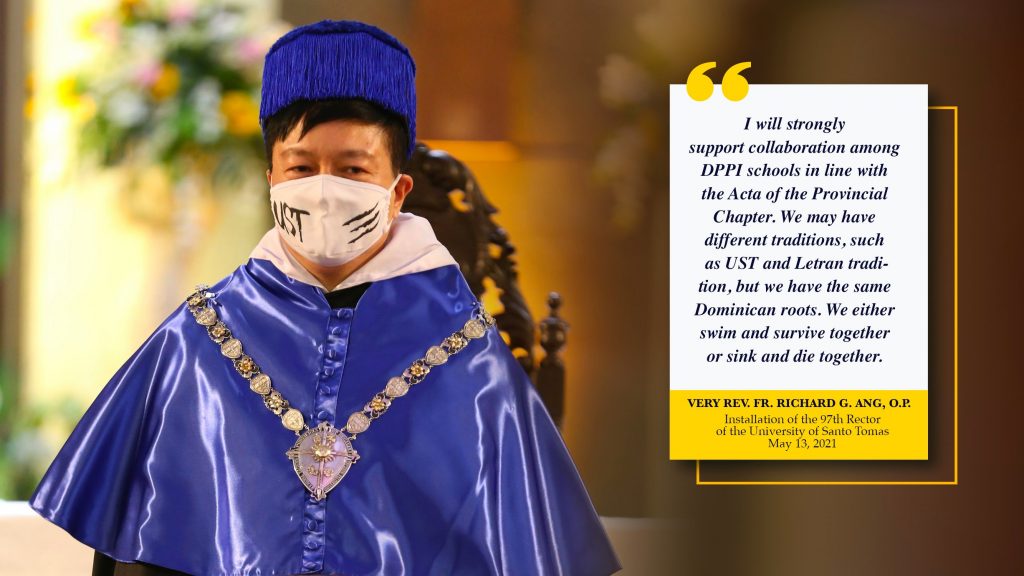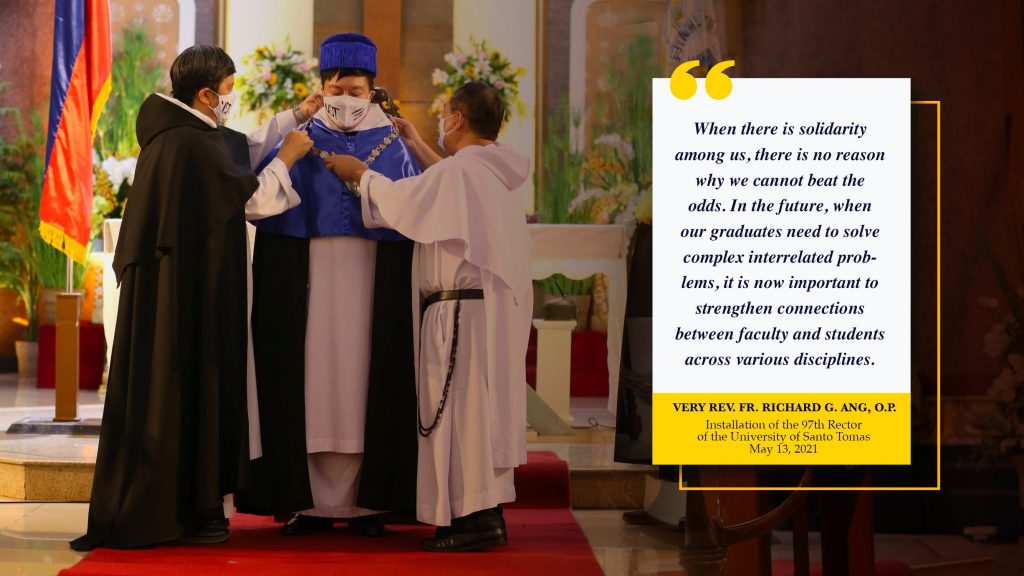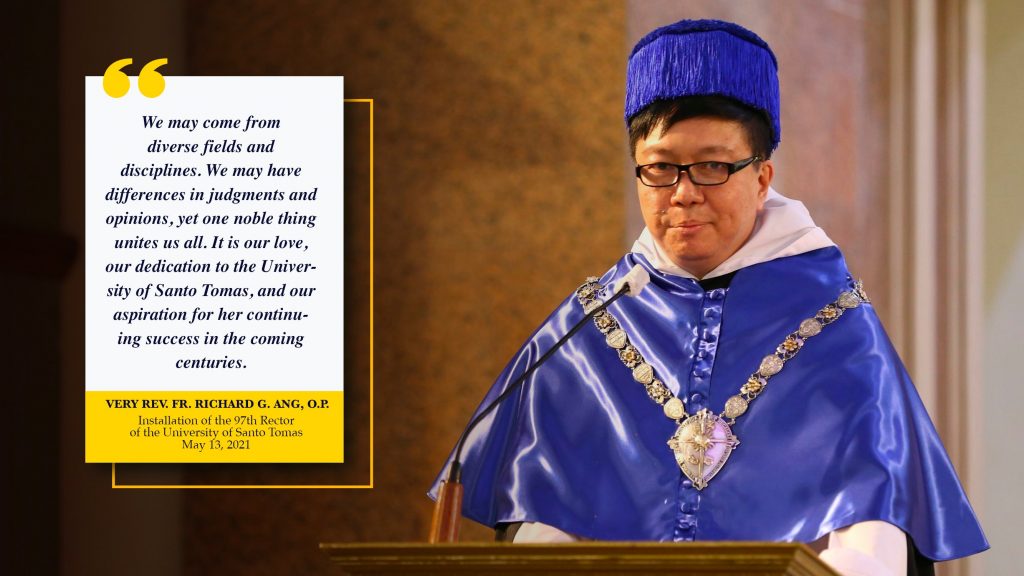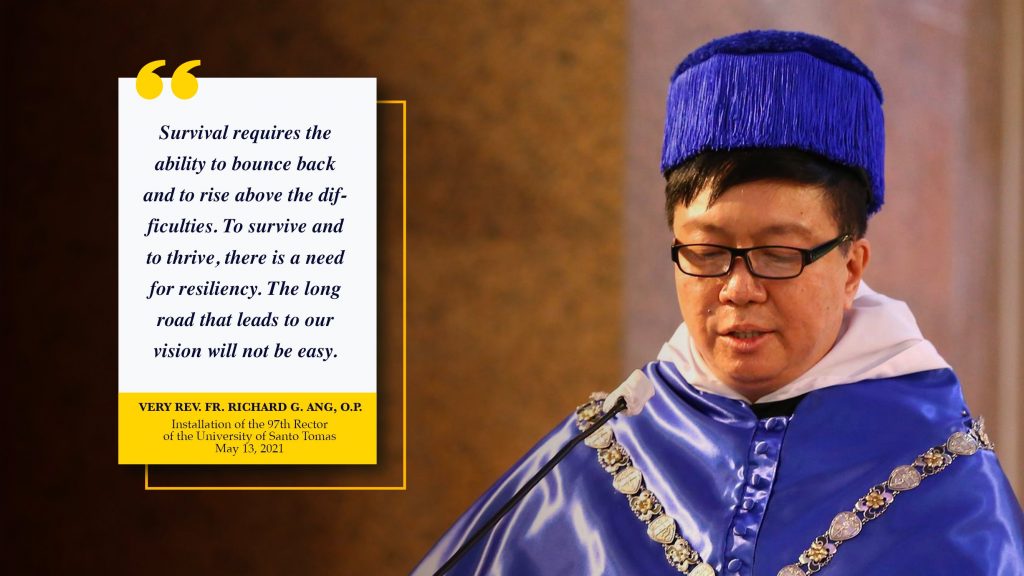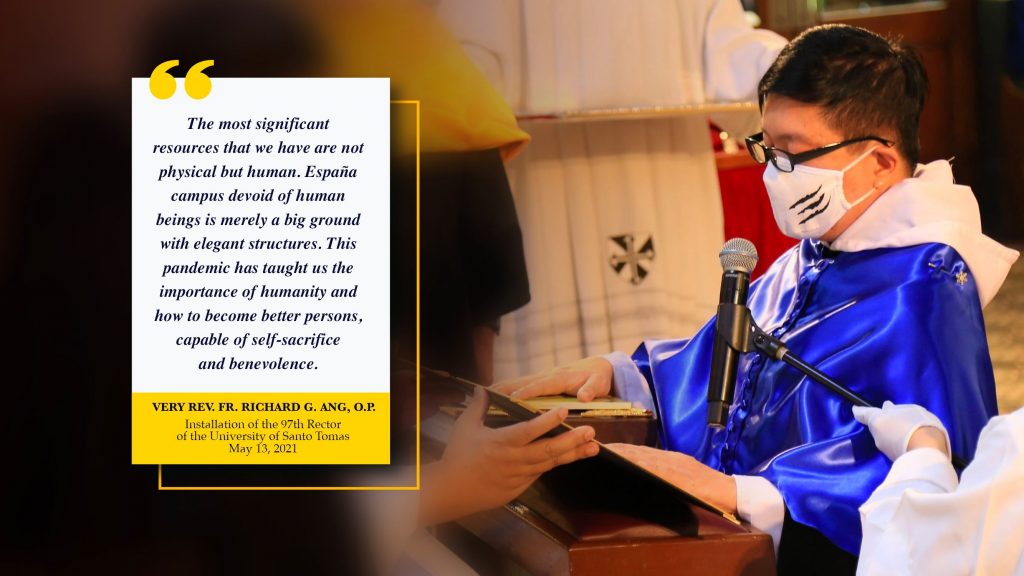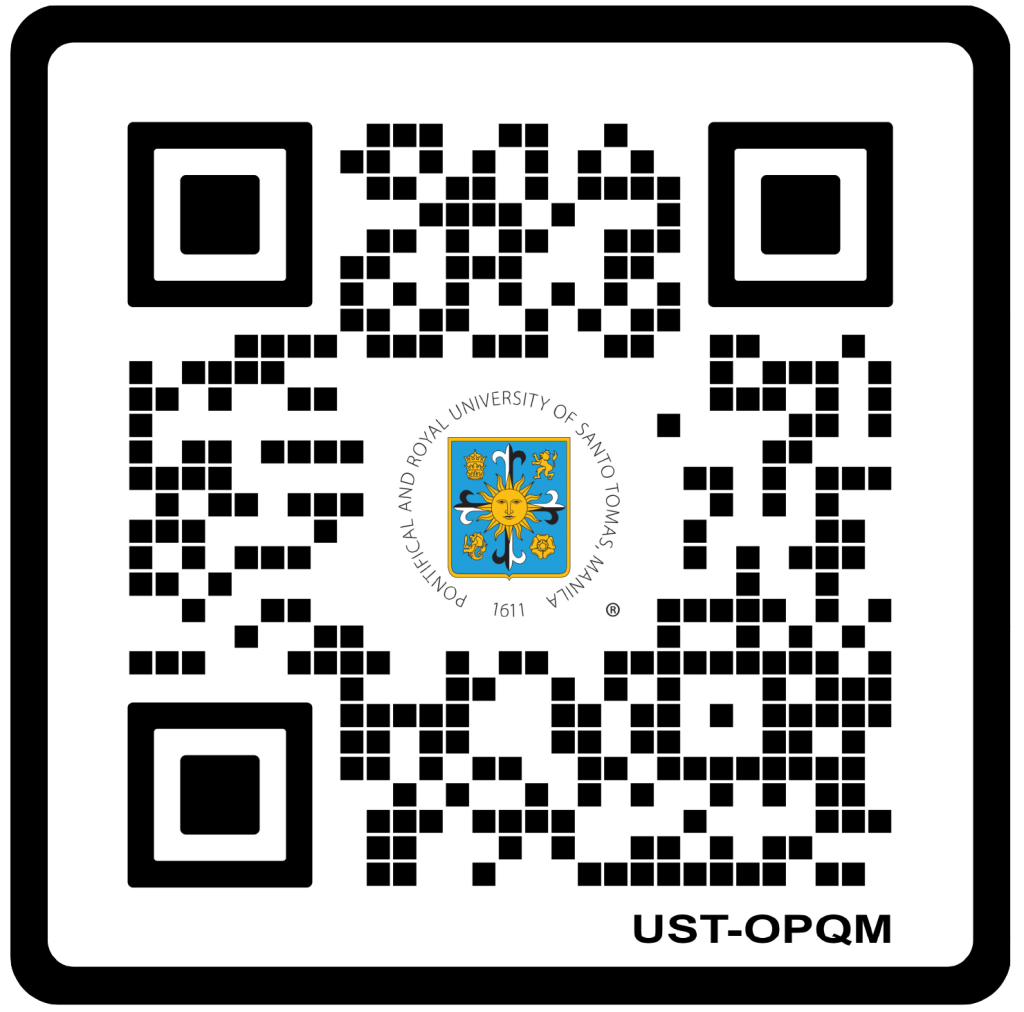The Very Rev. Fr. Richard G. Ang, O.P., PhD was installed as the 97th Rector of the University of Santo Tomas on May 13, 2021 (Thursday), on the occasion of the Feast of Our Lady of Fatima. In a simple ceremony in the Santísimo Rosario Parish Church, Fr. Ang made his Profession of Faith and Oath of Fidelity in front of the Very Rev. Fr. Filemon I. dela Cruz, Jr., O.P., Prior Provincial of the Dominican Province of the Philippines and Vice-Chancellor of the University of Santo Tomas.
2024 and Beyond
In his Address of Acceptance, Fr. Ang unveiled UST Vision 2024 and Beyond, which reads as follows: “By 2024 and the years to come, we would like to see UST to be recognized as one of the leading Catholic institutions of learning in the ASEAN region with the fastest-growing reputation in education, research, and service.”
To achieve this, the newly installed Rector underscored the importance of a quality culture that highlights UST’s excellence. The vision likewise established the 7-point framework that will guide Fr. Ang’s leadership until 2024.
Fr. Ang laid down the seven priorities as follows: 1) Harnessing Technology in Preparation for Industry 4.0, 2) Advance Synergy among Disciplines, Units, and Institutions, 3) Enrich the research ecosystem of the University, 4) Optimize advances made in internationalization, 5) Foster a stronger industry-academe-alumni partnership, 6) Advocate wellness of being, and 7) Manage Resources for Strategic Expansion.
The Very Rev. Fr. Richard Gaw Ang, O.P., PhD is UST’s 97th Rector and will serve until 2024. After securing the approval of the Sacred Congregation for Catholic Education in the Vatican, the Master of the Order of Preachers, the Very Rev. Fr. Gerard Francisco P. Timoner III, O.P., Master of the Order of Preachers, appointed Fr. Ang on May 7, 2020.
A philosopher, Father Ang was once Dean of the Faculty of Philosophy and was the University’s immediate past Vice-Rector. He earned his bachelor’s, licentiate, and doctorate degrees in UST with honors and specialized in Chinese philosophy and Philosophical Psychology.
A renewed commitment to our students
The Rector shared his vision for Thomasians of the modern era: “We want to see our graduates as trailblazers, initiators, game-changers of society; taking the lead and not trailing behind.” Recognizing the uncertainty of the times, the Rector reflected on the question of how and what kind of Thomasians will be formed in the coming years? To this, the Rector gave “Thomasian Education 4.0,” outcomes- and competency-based learning that incorporates technology and Catholic formation.
While being formed in the University, the Rector assured the members of the Thomasian community of a sustained advocacy for their wellbeing through the “crafting of innovative programs that will cater to spiritual, moral, physical, and psychological wellness.” Reminding the Thomasian community that our most important resource is people and not material resource, the Rector reflected on how the pandemic has shown “us the importance of humanity and how to become better persons capable of self-sacrifice and benevolence.”
Making a mark through synergy in research, teaching, and internationalization
Fr. Ang emphasized the need to “balance the contemporary and the classical,” to highlight the “complementarity of the natural sciences and the humanities,” which is important to developing critical thinking. “Technology alone is not enough. Technology married with the liberal arts, with humanities. Humans, unlike machines, have spirituality,” Fr. Ang said. The emphasis on ethical research that solves real-world problems was made by the Rector as he expressed his vision for UST to be “one of the rising research universities in the Asia-Pacific region.” This complementarity of the natural sciences and the humanities is key to the vision of the Rector for an enriched research ecosystem in Asia’s oldest existing University.
Translating this into instruction, the Rector exhorted the heads of academic units to explore ways to establish interdisciplinary ways of delivering instruction across the different units “to promote the sharing of expertise.” This experience lets itself to cooperation and collaboration, which are critical to achieving common goals in a “culture of support and rapport.” The invitation of more industry experts as adjunct faculty, as well as deeper immersions in the industry for students were also encouraged by the Rector, who saw the potential for students “to receive better input and produce greater output” from closer links between the academe and industry.
On internationalization, the Rector acknowledged that limitations in physical movement may make a dent on ongoing projects, such as student and faculty mobility, but called for creativity to sustain efforts to touch base with partner higher education institutions abroad. Fr. Ang also shared his vision of a diversified campus, which will be achieved by increasing the number of foreign students taking degree programs in UST. The diversification of students will also find parallels in the attempts to increase the international profile of faculty researcher.
Quoting Pope Francis in Veritatis Gaudium, the Rector made the commitment to “strongly support collaboration among DPPI [Dominican Province of the Philippines, Inc.] schools in line with the provision of the Acta of the 12th Provincial Chapter of the Dominican Province of the Philippines.” The differences in tradition among the schools, while real, are made easy to overcome by the shared Dominican roots. These collaborations are envisioned to be sustainable and mutually beneficial to help schools “swim and be saved together.”
The Rector likewise drew attention to the forthcoming campuses in Santa Rosa and General Santos, where the Thomasian brand of education will be brought. As the pandemic expectedly impacts on financial resources, the Rector said that the opening of these campuses will be done in “measured phases,” but while things “will start small,” efforts will be done to prepare the offering of academic programs in the said campuses.
Solidarity in uncertainty
Acknowledging that the current pandemic can make the responsibility of the Rector “a hundred times more challenging,” Fr. Ang, who began his work as Rector upon appointment on May 7, 2020, recalled how over the last year, way of life has been altered massively, but “despite the odds, we managed to stay afloat, and with God’s unending grace, we managed to create opportunities in the face of crisis.”
To navigate uncertain times, according to the Rector, requires the ability to change, which though despised at times, “is the same thing that will lead us to progress. At times, we need to swallow the bitter pill in order to get better.” In words of encouragement for Thomasians, the Rector said that he believes “that God has gifted the Thomasians with an internal mechanism not only designed for self-preservation but also for self-transformation. We continue to adapt to the changes no matter how disruptive they may be.” The Rector likewise highlighted the importance of our belief “in the power of prayer and in the capacity of people. With magnanimity, conquer all hurdles, we will!”
As the last year has shown, UST made the emergency shift to remote instruction and operations and has since the start of the academic year been implementing the Enriched Virtual Mode of instruction offered mainly through the UST CLOUD Campus. Reflecting on the continued use of distance education, the Rector said that “Distance education may be the present way to redefine boundaries and overcome limits. We have no other option but to embrace technology and innovate educational delivery,” Fr. Rector said. Believing in the value of solidarity, “When there is solidarity, there will be no reason to fail.”
Of gratitude and cooperation
Quoting 12th-century theologian John of Salisbury, the Rector likened ourselves to dwarves sitting on the shoulders of giants, whose height enables us to see more. Heaping praise on his predecessors, led by the immediate past Rector Fr. Herminio V. Dagohoy, O.P., Fr. Ang, who served as Vice-Rector during the two-term Rectorship of Fr. Dagohoy, thanked his predecessors “for their indelible contributions to the University.” He likewise thanked the current roster of University officials, led by Vice-Rector Fr. Isaias D. Tiongco, O.P., JCD, for “keeping the faithful watch [over UST] while I was on medical leave.”
The Rector counted gratitude as very important in moving forward as a community, for it “makes sense of the past and creates a vision for the future.” This future, though uncertain especially in the short-term, is one he hopes to show the synergy of the different talents and treasures of the Thomasian community.
Father Ang highlighted the soon-to-rise UST Tony Tan Caktiong Innovation Center in UST Sta. Rosa as an example of the benefits of industry-academe-alumni partnerships and of Thomasians helping one another by sharing resources. This benevolence and beneficence of Thomasians and even non-Thomasians who “pay it forward and leave a lasting legacy for the future Thomasians we will be serving” are crucial to navigating through uncertain times and still achieve our vision, the Rector said.



